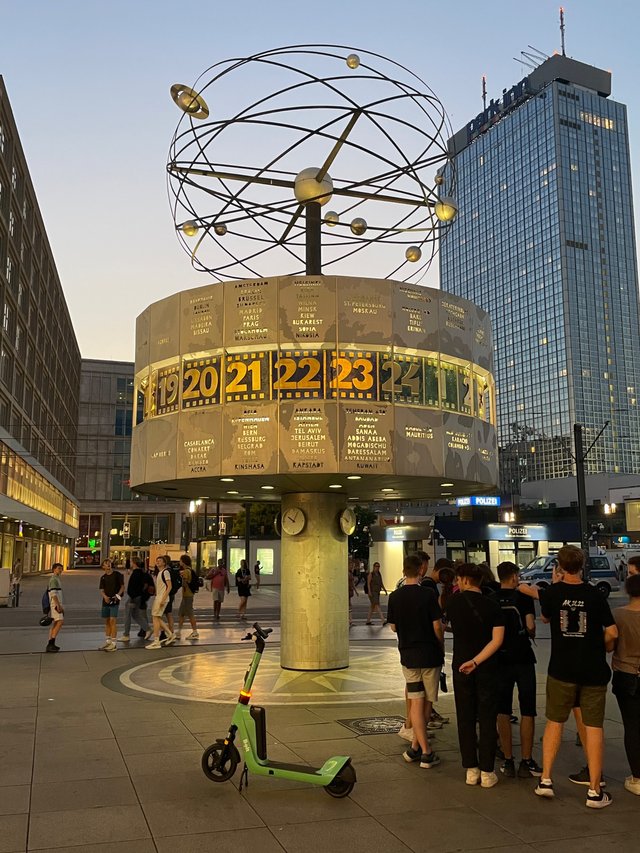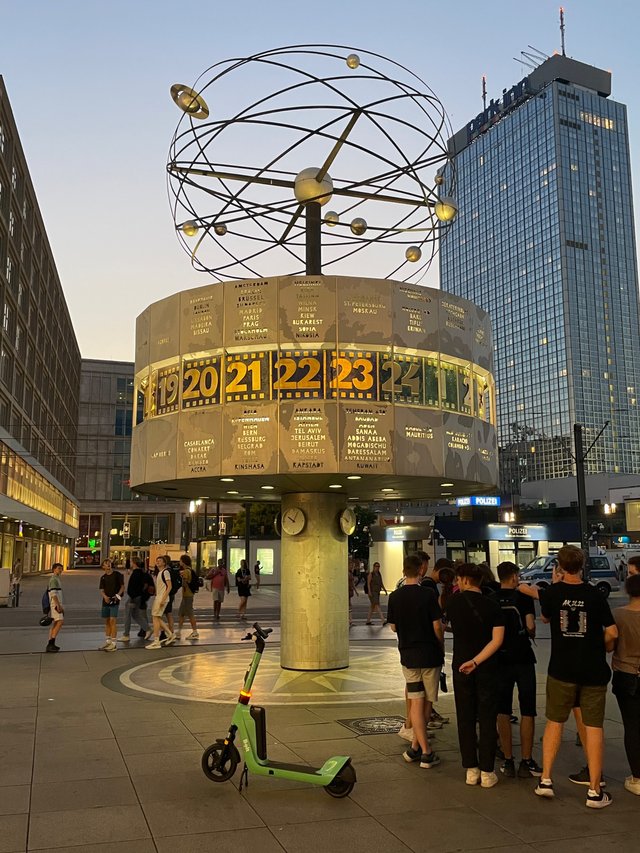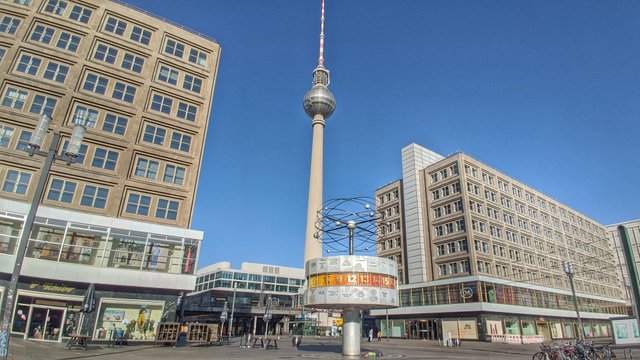The Urania World Time Clock: Berlin's Historic Meeting Place on Alexanderplatz
In the middle of the bustling Alex, right next to the TV Tower, stands another Berlin landmark that serves not only as a useful instrument, but also as a popular meeting place for Berliners and tourists - the Urania World Time Clock.

Architecture and design
The World Time Clock, originally known as the "Urania World Time Clock", was designed and built by Erich John in 1969. Its design is a mixture of functionality and modern, almost futuristic appearance, about whose aesthetics one can certainly be divided. Above a stone mosaic embedded in the floor in the form of a wind rose, this monster is enthroned on a stately column. The clock consists of three discs of which the central hour ring with the numbers 1-24 rotates over the 24 sides representing the main time zones of our earth (each bears on its aluminum surface the engraved names of important cities from these time zones). The massive apperature, is a proud ten meters high and weighs an impressive 16 tons. As a fascinating extra, a simplified representation of our solar system rotates above the world time clock. This miniature model includes planets as spheres depicted on their orbits - with steel circles representing these orbits.
A look at history
The Urania World Time Clock was originally erected on the site where a large advertising pillar used to stand. While this pillar provided information for citizens, the world time clock had a similar task. In an era before smartphones and fast internet, the World Time Clock was an important focal point for travelers and locals to find out the current time in their distant hometowns.
In the 1960s, during the Cold War, the World Time Clock on Alexanderplatz was also considered a symbol of international understanding.
Popular meeting place
The World Time Clock not only serves to display the current time in various cities around the world, but also fulfills an important social function - it is an important meeting place. With its central location on Alexanderplatz, it is often used as a starting point for city explorations in Berlin Mitte. Thanks to its historical significance and iconic design, it is a popular place for dates and meetings.
The World Time Clock has managed to hold its own in Berlin's ever-changing urban landscape and is an impressive example of how an architectural element with social significance can become a timeless landmark.
Die Urania-Weltzeituhr: Berlins Historischer Treffpunkt auf dem Alexanderplatz
Mitten auf dem geschäftigen Alex steht direkt neben dem Fernsehturm ein weiteres Wahrzeichen Berlins, das nicht nur als nützliches Instrument, sondern auch als beliebter Treffpunkt für Berliner und Touristen dient - die Urania-Weltzeituhr.

Architektur und Design
Die Weltzeituhr, ursprünglich als "Urania-Weltzeituhr" bekannt, wurde 1969 von Erich John entworfen und erbaut. Ihr Design ist eine Mischung aus Funktionalität und modernem, fast futuristischem Aussehen, über dessen Ästhetik man sicher geteilter Meinung sein kann. Über einem im Boden eingelassenen Steinmosaik in Form einer Windrose thront dieses Ungetüm auf einer stattlichen Säule. Die Uhr besteht aus drei Scheiben von denen sich der mittlere Stundenring mit den Zahlen von 1-24 über die Haupt-Zeitzonen unserer Erde repräsentierenden 24 Seiten (jede trägt auf ihrer Aluminiumoberfläche die eingravierten Namen wichtiger Städte aus diesen Zeitzonen) dreht . Die gewaltige Apperatur, ist stolze zehn Meter hoch und beeindruckende 16 Tonnen schwer. Als faszinierendes Extra rotiert über der Weltzeituhr eine vereinfachte Darstellung unseres Sonnensystems. Dieses Miniaturmodell umfasst Planeten als Kugeln, die auf ihren Bahnen dargestellt sind – mit Stahlkreisen als Repräsentation dieser Bahnen.
Ein Blick in die Geschichte
Die Urania-Weltzeituhr wurde ursprünglich an der Stelle errichtet, an der früher eine große Litfaßsäule stand. Während diese Säule Informationen für die Bürger bereithielt, hatte die Weltzeituhr eine ähnliche Aufgabe. In einer Zeit vor Smartphones und schnellem Internet war die Weltzeituhr ein wichtiger Anlaufpunkt für Reisende und Einheimische, um sich über die aktuelle Zeit in ihren fernen Heimatstädten zu informieren.
In den 1960er Jahren, während des Kalten Krieges, galt die Weltzeituhr auf dem Alexanderplatz auch als Symbol der Völkerverständigung.
Beliebter Treffpunkt
Die Weltzeituhr dient nicht nur der Anzeige der aktuellen Uhrzeit in verschiedenen Städten weltweit, sondern erfüllt auch eine wichtige soziale Funktion - sie ist ein wichtiger Treffpunkt. Mit ihrer zentralen Lage auf dem Alexanderplatz wird sie oft als Ausgangspunkt für Stadterkundungen in Berlin Mitte genutzt. Dank ihrer historischen Bedeutung und ihres ikonischen Designs ist sie ein beliebter Ort für Verabredungen und Treffen.
Die Weltzeituhr hat es geschafft, sich in der sich ständig wandelnden Stadtlandschaft Berlins zu behaupten und ist ein beeindruckendes Beispiel dafür, wie ein architektonisches Element mit sozialer Bedeutung zu einem zeitlosen Wahrzeichen werden kann.
Wer Berlin besucht, sollte unbedingt die Weltzeituhr auf dem Alexanderplatz besichtigen. Sie ist nicht nur ein Beispiel für modernes Design, sondern auch ein lebendiges Zeugnis der Geschichte und ein Ort der Begegnung, der Berlinern und Touristen gleichermaßen am Herzen liegt.
 |  |  |
| Don't forget to reshare! | For every reshare/rehive your will get one of my Proof-of-Reshare NFTs. Current Edition: Morticia #2 only 10 pices | Don't forget to reshare! |

Congratulations @city-of-berlin! Your post made the TravelFeed team happy so we have sent you our big smile. Keep up the good job. 😃
Thanks for using TravelFeed!
@for91days (TravelFeed team)
PS: Did you know that we recently launched the truvvl app? With truvvl, you can create travel stories on the go from your phone and swipe through nearby stories from other TravelFeed users. It is available on the Apple App Store and Google Play.